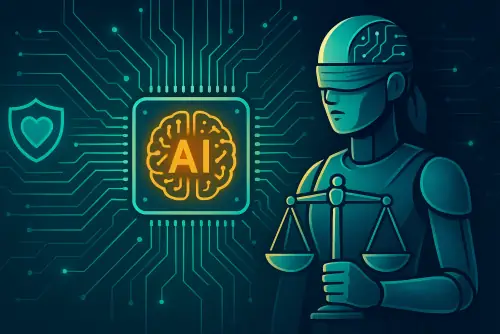As Artificial Intelligence becomes increasingly integrated into the software that powers our world, the ethical implications of its development and deployment are more critical than ever. Developers are at the forefront of this technological wave, and with great power comes great responsibility. Building AI systems that are not only intelligent but also responsible, fair, and transparent is paramount. Understanding the foundational concepts of AI, ML, and Deep Learning is the first step.
Why Ethics in AI Matters More Than Ever
AI systems make decisions that can profoundly impact individuals and society:
- Bias Amplification: AI models trained on biased data can perpetuate and even amplify existing societal biases, leading to unfair outcomes in areas like loan applications, hiring processes, or even criminal justice. This is explored in depth in Bias in AI: Understanding and Mitigating Unfairness.
- Lack of Transparency (Black Box Problem): Many complex AI models, particularly deep learning networks, can be difficult to interpret. Understanding why an AI made a particular decision is crucial for accountability and trust. This is a challenge even in areas like AI-assisted debugging.
- Privacy Concerns: AI systems often require vast amounts of data to train, raising significant concerns about how this data is collected, used, and protected. Proper data cleaning and preparation are essential but must be done ethically.
- Accountability and Responsibility: When an AI system causes harm, determining who is responsible—the developers, the deployers, or the AI itself—can be challenging.
- Job Displacement and Economic Impact: While AI creates new opportunities, as seen with AI pairing for developers, it also raises concerns about job displacement in certain sectors, requiring thoughtful societal adaptation.
Core Principles of Ethical AI Development
Developers should strive to incorporate these core principles into their AI development lifecycle:
Fairness and Non-Discrimination:
- Actively work to identify and mitigate biases in training data and model algorithms.
- Strive for equitable outcomes across different demographic groups.
- Regularly audit AI systems for biased behavior.
Transparency and Explainability (XAI):
- Whenever possible, use AI models that are inherently more interpretable. Techniques for this are part of ongoing machine learning research.
- Employ XAI techniques (e.g., LIME, SHAP) to provide insights into how models arrive at their decisions.
- Clearly communicate the capabilities and limitations of AI systems to users, which is also a principle in AI in UI/UX Design.
Accountability and Governance:
- Establish clear lines of responsibility for the design, development, deployment, and maintenance of AI systems.
- Implement robust testing and validation processes that include ethical considerations.
- Develop mechanisms for redress when AI systems cause harm.
Privacy and Security:
- Adhere to data minimization principles, collecting only necessary data.
- Employ privacy-preserving techniques like federated learning or differential privacy where appropriate.
- Ensure robust security measures to protect data used by and generated by AI systems.
Human Oversight and Control:
- Design AI systems to augment human capabilities, not to operate with complete autonomy in critical decision-making processes.
- Ensure there are mechanisms for human intervention and override, especially in high-stakes applications.
"Building ethical AI is not a one-time checklist; it's an ongoing commitment to vigilance, reflection, and continuous improvement woven into the fabric of the development process."
Practical Steps for Developers
- Educate Yourself and Your Team: Stay informed about ethical AI frameworks, best practices, and potential societal impacts. Understand the key concepts of ML to better grasp the implications.
- Diverse and Inclusive Teams: Foster diversity in development teams to bring a wider range of perspectives, which can help identify and mitigate biases.
- Data Diligence: Scrutinize training datasets for potential biases. Explore techniques for data augmentation or re-weighting to address imbalances. This involves careful feature engineering.
- Choose Appropriate Models: Consider the trade-offs between model accuracy and interpretability. Is a slight dip in accuracy acceptable for a model that is much easier to explain? Evaluating models using appropriate classification or regression metrics should also consider fairness.
- Incorporate Ethical Reviews: Make ethical considerations a formal part of your code review and design review processes, similar to how vibe coding sessions encourage holistic review.
- User-Centric Design: Involve users and stakeholders in the design process to understand their concerns and ensure the AI system aligns with their values and expectations. This is critical when building AI tech bloggers with RAG or any user-facing AI.
- Post-Deployment Monitoring: Continuously monitor AI systems in production for unintended consequences or performance degradation related to fairness and bias, including issues like overfitting or underfitting.
The Path Forward: Responsibility by Design
Developing AI ethically is not just about avoiding negative consequences; it's about proactively building systems that contribute positively to society. By embedding ethical principles into the core of our development practices—responsibility by design—we can harness the transformative power of AI for the greater good. This includes creating smarter documentation with AI in an ethical manner.
As developers, we have a unique opportunity and an important duty to shape an AI-powered future that is equitable, just, and beneficial for all.
What are the biggest ethical challenges you see in AI development today? How can the developer community better address them?

Comments